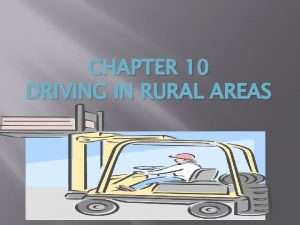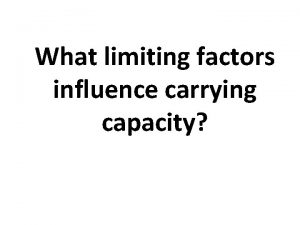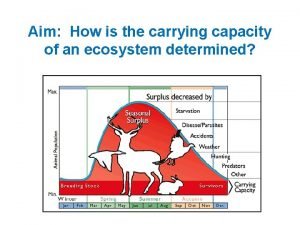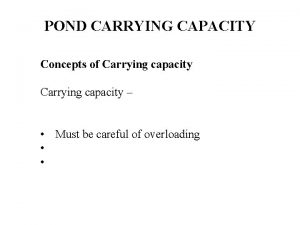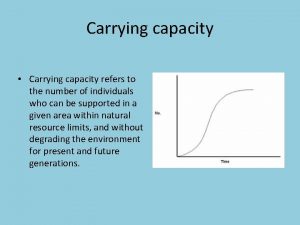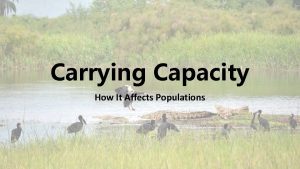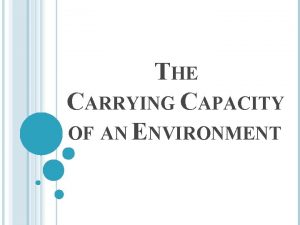Carrying Capacity in Rural Areas Carrying capacity is

















- Slides: 17

Carrying Capacity in Rural Areas Carrying capacity is…. The maximum number of visitors/participants that a site/event can satisfy at one time

Types of carrying capacity: • Physical carrying capacity • Environmental carrying capacity • Perceptual carrying capacity a honeypot site – biggest attraction in an area - attracts tourists like bees to honey

Traffic congestion and overcrowding If the car park is full then physical carrying capacity has been reached – no more visitors can be accommodated

Footpath erosion – The environmental carrying capacity been exceeded (the maximum number ppl before the local environment becomes damaged) where vegetation can no longer grow due to excessive hiking on most popular trails

Perceptual carrying capacity……… The maximum number before a specific group of visitors considers the level of impact, such as noise, to be excessive

Problems if a destination exceeds its carrying capacity include: • Tensions between locals and tourists • Deforestation • Congestion • Water pollution from increased waste • Water shortages from increased demand • Air pollution from increased cars and flights • Footpath erosion • Damage to archaeological sites • Power black-outs • Visual and noise pollution • Disturbance of wildlife • Reduction in visitor numbers

What about Everest? • Physical • Environmental • Perceptual Has the rural honeypot site Mt. Everest reached its carrying capacity?


Alpine Tourism: how to. . ? • Maximize capacity? - Avoid environmental damage • Minimize conflict? - Between residents vs visitors

Watch: Sherpa Brawl on Everest (videos linked below) - Ensure you look at both videos before copying notes below. Vid#1 - https: //www. youtube. com/watch? v=r. E 71 p. Zbk. CDI Vid#2 - https: //www. youtube. com/watch? v=p. Aa. VK 8 e. Jsfo

Social Impact • April 27, 2013 Everest brawl between Swiss climbers and sherpas when foreign climbers try to climb Lhotse face when sherpas working on the ropes • April 18, 2014 avalanche in Khumbu Icefall kills 16 sherpas, causing others to go on strike as many work without insurance

Environmental Impact • Catering to the needs of the crowds translates into an increase in rubbish, further deforestation due to lodges’ construction and heating, and erosion of mountain paths • Water scarcity is present in Nepal, the result of receding glaciers due to global warming, as well as water pollution induced by contamination of freshwater with human and animal waste, have led many environmentalists to raise the alarm. Sagarmatha National Park Aka: Mt. Everest

Rural Tourism Management: What changes would you make to establish sustainable management strategies?

The best tourist strategies will maximize visitor numbers but not at them expense of local people or the environment. ie. They are sustainable ‘Meeting the needs of the present without compromising the ability of future generations to meet their own needs using the same resources. ’

So…. after 2013 “Everest Brawl” 1. Climbers on Everest now must bring back 8 kg (17. 6 lbs) of garbage under new rules instituted by Nepalese officials! (2014) 2. New office set up to collect trash (or lose $4000 deposit), resolve conflicts (local soldiers and police), and provide medical aid “Alpine Tourism” – Enforcement is an Issue!

3. Slowly acquiring labour rights to Nepali and Sherpas • Although death rate has fallen for western climbers, for Sherpas is 12 x higher than death rate of US soldiers in Iraq • After devastating avalanche in 2014 killed 16 Sherpas, rest of native climbers went on strike for remainder of climbing season • Sherpas demanded higher compensation for families of perished climbers ($1000), or disabled climbers ($10 000), establish monument to deceased Sherpas, raise insurance rates

Other Suggested Sustainable Strategies • Many suggest transfer of ownership of foreign-owned climbing companies to local ownership • Limits and caps on number of companies operating and number of climbers in each company.
 Chapter 15 driving in rural areas
Chapter 15 driving in rural areas Urban and rural difference
Urban and rural difference Chapter 10 driving in rural areas worksheet answers
Chapter 10 driving in rural areas worksheet answers Chapter 10 driving in rural areas
Chapter 10 driving in rural areas Usda rural areas in massachusetts
Usda rural areas in massachusetts Chapter 15 driving in rural areas
Chapter 15 driving in rural areas Limiting resources biology
Limiting resources biology Demographic transition model ap human geography
Demographic transition model ap human geography Relationship between population and carrying capacity
Relationship between population and carrying capacity Carrying capacity
Carrying capacity Carrying capacity diagram
Carrying capacity diagram Boxn wagon dimensions
Boxn wagon dimensions Carrying capacity example
Carrying capacity example Carrying capacity exponential growth
Carrying capacity exponential growth Whats carrying capacity
Whats carrying capacity Thomas malthus carrying capacity
Thomas malthus carrying capacity Exponential growth and carrying capacity
Exponential growth and carrying capacity Carrying capacity of pond
Carrying capacity of pond


